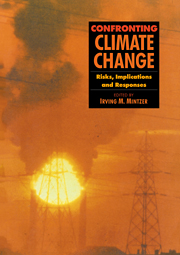Book contents
- Frontmatter
- Contents
- Foreword
- Acknowledgements
- List of Reviewers
- 1 Living in a Warming World
- I The Science of Climate Change
- II Impacts of Global Climate Change
- 7 Future Sea Level Rise: Environmental and Socio-Political Considerations
- 8 Effects of Climate Change on Food Production
- 9 Effects of Climate Change on Shared Fresh Water Resources
- 10 Effects of Climate Change on Weather-Related Disasters
- 11 The Effect of Changing Climate on Population
- III Energy Use and Technology
- IV Economics and the Role of Institutions
- V Equity Considerations and Future Negotiations
- Annex I
- Annex II
- Glossary
- Index
7 - Future Sea Level Rise: Environmental and Socio-Political Considerations
Published online by Cambridge University Press: 06 January 2010
- Frontmatter
- Contents
- Foreword
- Acknowledgements
- List of Reviewers
- 1 Living in a Warming World
- I The Science of Climate Change
- II Impacts of Global Climate Change
- 7 Future Sea Level Rise: Environmental and Socio-Political Considerations
- 8 Effects of Climate Change on Food Production
- 9 Effects of Climate Change on Shared Fresh Water Resources
- 10 Effects of Climate Change on Weather-Related Disasters
- 11 The Effect of Changing Climate on Population
- III Energy Use and Technology
- IV Economics and the Role of Institutions
- V Equity Considerations and Future Negotiations
- Annex I
- Annex II
- Glossary
- Index
Summary
Editor's Introduction
Many people assume that sea level and climate have been stable over the eons of the geologic past. In both cases, this assumption is far from the truth. The average level of the seas has risen and fallen substantially over the last 100,000 years — principally due to the advance and retreat of the large continental ice sheets associated with the last ice age. Changes in sea levels have also been observed over shorter time horizons. These changes have reflected both oceanographic fluctuations (e.g. shifts in ocean currents) and atmospheric changes (e.g. atmospheric pressure changes).
In this chapter, Richard Warrick and Atiq Rahman point out that global warming is expected to cause the Earth's mean sea level to rise. The extent of that rise is uncertain, but it is likely to be caused by two factors: the melting of land ice and the thermal expansion of the ocean. By contrast, the melting of sea ice floating in a warmer ocean will not raise the level of the seas, just as the melting of an ice cube in a glass of water does not raise the level of liquid in the glass.
Journalistic sensationalism has frightened much of the public with visions of a catastrophic 5-metre sea level rise that will inundate huge coastal areas. But these authors suggest (and most responsible scientists agree) that this is not very likely during the next century. Instead, today's best scientific estimate of average global sea level rise is about 60 cm, with a large uncertainty range of ±45 cm, if we continue on a “business-as-usual” path of greenhouse gas emissions.
- Type
- Chapter
- Information
- Confronting Climate ChangeRisks, Implications and Responses, pp. 97 - 112Publisher: Cambridge University PressPrint publication year: 1992
- 4
- Cited by

